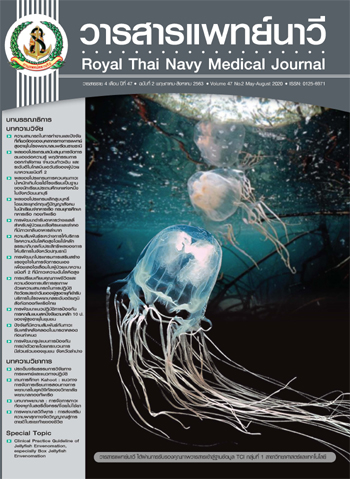Effects of a School-Based Overweight Control Program on Primary School Students in Nonthaburi Province
Main Article Content
Abstract
This one group pretest-posttest quasi-experimental design aimed to investigate the effects of a school-based overweight control program on primary school students, in Nonthaburi province. The sample was selected by purposive sampling with the inclusion criteria consisted of 31 primary school students who were overweight and obese. Research instruments included a school-based overweight control program on primary school students, knowledge and behavior regarding overweight control questionnaires. The content validity indexes of overweight control knowledge and behavior questionnaire was 0.86. Kuder-Richardson 20 of overweight control knowledge test was 0.71 and Cronbach’s alpha coefficients of overweight control behavior test was 0.74. Data were analyzed by descriptive statistic and paired t-test.
The research results revealed that after participating in this program: 1) the sample had statistically significant higher mean score of knowledge regarding overweight control than before participating the program (p < .001), 2) the sample had no difference in mean score of behavior regarding overweight control than before participating the program and 3) the sample had no difference body weight than before participating in this program.
The results shown that the program can improve the knowledge. However there were no difference in behavior regarding overweight control and body weight. These might be related to the limited duration of evaluating the outcome. This need to extend longer than a month to explore the obvious change in outcome.
Article Details

This work is licensed under a Creative Commons Attribution-NonCommercial-NoDerivatives 4.0 International License.
References
2. Pulgaron ER. Childhood obesity: a review of increased risk for physical and psychological comorbidities. Clinical Therapeutics 2013;35(1):18-32.
3. No-in K. Overweight and obesity among Thai school-aged children and adolescents. Journal of the Royal Thai Army Nurses 2017;18(suppl.):1-18. (in Thai).
4. Kumar S, Kelly, AS. Review of childhood obesity: from epidemiology, etiology, and comorbidities to clinical assessment and treatment. Mayo Clin Proc 2017;92(2):251-65.
5. WHO. Consideration of the evidence on childhood obesity for the commission on ending childhood obesity. Geneva: WHO; 2016.
6. Bureau of Nutrition, Department of Health. Guideline for controlling and prevention obesity in school age. Nonthaburi: Ministry of Public Health; 2017. (in Thai).
7. Department of Health, Ministry of Public Health. Guideline for controlling and prevention over nutrition in school age. Nonthaburi: Ministry of Public Health; 2018. (in Thai).
8. Health Promotion Division, Ministry of Public Health. Guideline for child development. Nonthaburi: Ministry of Public Health; 2014. (in Thai).
9. Nakrapanich S, Puengsema R, Suwanpatikorn K. The effect of empowerment program in health promotion on food consumption behaviors, exercise behaviors, and nutritional status of junior high school students. Journal of Public Health Nursing 2012;26(1):32-50. (in Thai).
10. Pichairat A, Chuaykaew B, Lertwanawattan J. The effect of promotion role of family program on the knowledge behaviors for weight control among the overweight school – age. In: National academic conference and research presentation 1st academic capital "Enhancing interdisciplinary Combines Thai culture Step confidently into the AC"; July 29,2016. Ratchathani university, Ubon Ratchathani; p.1784-94. (in Thai).
11. Amini M, Djazayery A, Majdzadeh R, Taghdisi MH, Jazayeri S. Effect of school-based interventions to control childhood obesity: a review of reviews. Int J Prev Med 2015;6:68. DOI: 10.4103/2008-7802.162059.
12. Lloyd JJ, Logan S, Greaves CJ, Wyatt KM. Evidence, theory and context-using intervention mapping to develop a school-based intervention to prevent obesity in children. Int J Behav Nutr Phys Act 2011;(8):73. doi: 10.1186/1479-5868-8-73.
13. Kar SS, Dube R, Kar SS. Childhood obesity-an insight into preventive strategies. Avicenna Journal Medicine. 2014;4(4):88-93.
14. Nancy DB. Applying the school health index to a nationally representative sample of schools. The Journal of School Health 2006;76(2):81-90.
15. Bandura A. Social learning theory. New Jersey: Prentice-Hall; 1977.
16. Chaisri J, Klungtumneim K, Buajarean H. Clinical nursing practice guideline for management of obesity in children: the synthesis of thesis. Journal of the Royal Thai Army Nurses 2014;15(2):360-67. (in Thai).
17. Pediatric Nutrition Association of Thailand. Guidelines for the prevention and treatment of obesity in children. Nonthaburi: Department of Health, Ministry of Public Health; 2014. p. 1-34. (in Thai).
18. Polit DF, Beck CT. Nursing research: principles and methods. 7th ed. Philadelphia: Lippincott Williams & Wilkins; 2004.
19. Sanprik S. The effects of health education program applying self-efficacy theory towards weight control among grade 6 students at Kajonkietsuksa School, Phuket province. Journal of Community Health Development Quartery Khon Kaen University 2016;5(2):297-314. (in Thai).
20. Ketasingh W. Mean with interpretation: easy thing that can sometimes be missed. Educational research news 1995;18(3):8-10. (in Thai).
21. Buapian A, Hansakul A, Tornee S, Bunchonhatthakit P. The developing guidelines of health promotion activities for body weight controlling among over nutrition students. Journal of Faculty of Physical Education 2014;17(1):141-52. (in Thai).
22. Konthongtom T, Nookong A, Sangperm P. Effects of weight control program on eating and physical activity behaviors among school-aged children with overweight. Journal of Nursing Science Chulalongkorn University 2018;30(2):28-40. (in Thai).
23. Golan M, Weizman A. Familial approach to the treatment of childhood obesity: conceptual model. Journal of Nutrition Education 2001;33(2):102.


